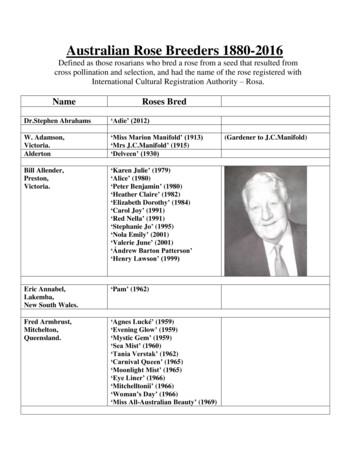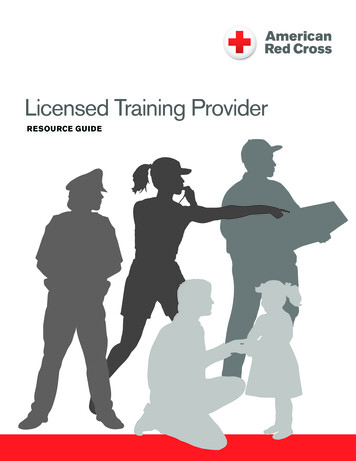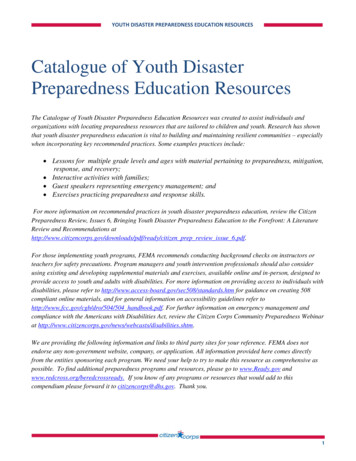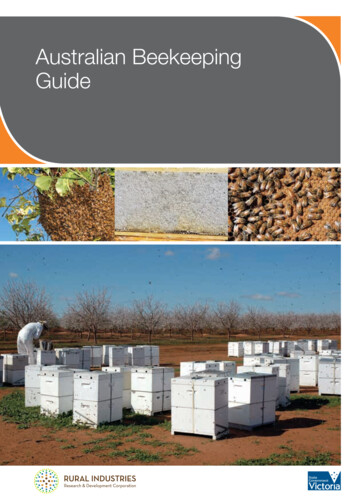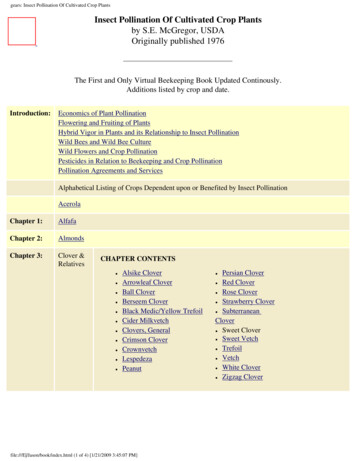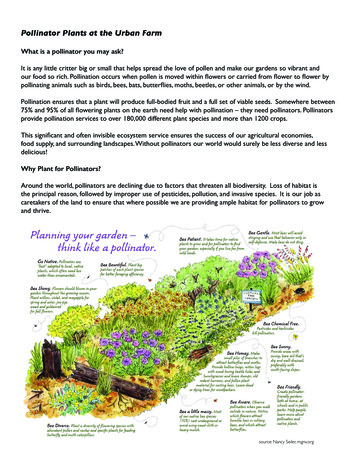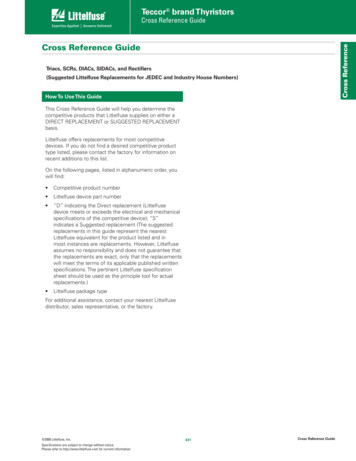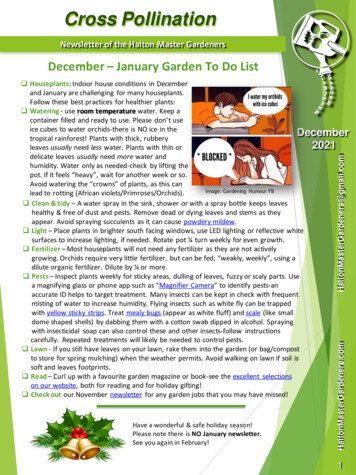
Transcription
Cross PollinationNewsletter of the Halton Master GardenersDecember – January Garden To Do ListHave a wonderful & safe holiday season!Please note there is NO January newsletter.See you again in eners@gmail.com Houseplants: Indoor house conditions in Decemberand January are challenging for many houseplants.Follow these best practices for healthier plants: Watering - use room temperature water. Keep acontainer filled and ready to use. Please don’t useice cubes to water orchids-there is NO ice in theDecembertropical rainforest! Plants with thick, rubbery2021leaves usually need less water. Plants with thin ordelicate leaves usually need more water andhumidity. Water only as needed-check by lifting thepot. If it feels “heavy”, wait for another week or so.Avoid watering the “crowns” of plants, as this canImage: Gardening Humour FBlead to rotting (African violets/Primroses/Orchids). Clean & tidy – A water spray in the sink, shower or with a spray bottle keeps leaveshealthy & free of dust and pests. Remove dead or dying leaves and stems as theyappear. Avoid spraying succulents as it can cause powdery mildew. Light – Place plants in brighter south facing windows, use LED lighting or reflective whitesurfaces to increase lighting, if needed. Rotate pot ¼ turn weekly for even growth. Fertilizer – Most houseplants will not need any fertilizer as they are not activelygrowing. Orchids require very little fertilizer, but can be fed, “weakly, weekly”, using adilute organic fertilizer. Dilute by ¼ or more. Pests – Inspect plants weekly for sticky areas, dulling of leaves, fuzzy or scaly parts. Usea magnifying glass or phone app such as “Magnifier Camera” to identify pests-anaccurate ID helps to target treatment. Many insects can be kept in check with frequentmisting of water to increase humidity. Flying insects such as white fly can be trappedwith yellow sticky strips. Treat mealy bugs (appear as white fluff) and scale (like smalldome shaped shells) by dabbing them with a cotton swab dipped in alcohol. Sprayingwith insecticidal soap can also control these and other insects-follow instructionscarefully. Repeated treatments will likely be needed to control pests. Lawn - If you still have leaves on your lawn, rake them into the garden (or bag/compostto store for spring mulching) when the weather permits. Avoid walking on lawn if soil issoft and leaves footprints. Read – Curl up with a favourite garden magazine or book-see the excellent selectionson our website, both for reading and for holiday gifting! Check out our November newsletter for any garden jobs that you may have missed!1
Cross PollinationThe Well Travelled TrugBy Halton Master Gardener Pam MacDonaldThe one pictured here dates tothe1950s and has seen service inBritain, Nigeria, Tanganyika (nowTanzania), Brazil, the USAand Canada. It belonged to mymother-in-law and travelled theworld with her until she gifted itto �s a bittersweet time of year. Bulbs have been planted, the garden shovel hastraded places with the snow shovel. I reluctantly think about putting my toolsaway, including my favorite piece of gardening paraphernalia, my Sussex Trug.What, you may ask is a Sussex Trug? It is an indispensable gardening accessory forlugging your trowel, snippers, gloves and other bibs and bobs with you around thegarden.Like my mother-in-law, theSussex Trug halesfrom Herstmonceux (pronouncedHurst-man-zoo) Sussex, England.HaltonMasterGardeners.comThe Sussex Trug was the reinvention, by ThomasSmith, of the ancient Anglo Saxon ‘trog’, aheavy solid wood container. Smith's design wasa lightweight basket crafted from SweetChestnut (Castaneda sativa) for the handle andrim, and strips of Cricket Bat Willow (Salixcoerulea) for the body. It caught the eye ofQueen Victoria at The Great Exhibition at TheCrystal Palace, Hyde Park London in 1851. Sheordered 100 of them.So grateful was Thomas Smith for this royalpatronage that he delivered the orderpersonally, pushing his handcart the 60 milesfrom Herstmonceaux to Buckingham Palace.While the currently living, 4 generations of ourfamily, don't all agree on the role of themonarchy in the 21st century, we do all agree"Long Live the g-company/2
Cross PollinationChristmas Fern and FriendsBy HaltonMasterGardenerAllynWalshBy HaltonMasterGardenerAllynWalshHere in Ontario we often see ferns when walking in woodlands- they can be abeautiful addition to the garden when sited properly. These ancient plants can besomewhat mysterious to the gardener and in this article we will examine theirunique structure and highlight just a few of the ferns native to our Ferns look different!Our more familiar garden perennials and annuals areclassified as Angiosperms – they all have flowers andseeds, even if some are rather inconspicuous. Ferns onthe other hand are Pterophyta – also vascular plants butones that produce spores rather than seeds.We are all familiar with the graceful fronds – the wholefern “leaves” that arises directly from the root. Eachfrond consists of a stalk (or stipe) and a blade whichcarries the leaflets (also known as pinna). Fiddleheadsare the emerging fern plant in spring, so called becauseof their resemblance to the end of a fiddle. Ferns haveneither flowers nor seeds – rather they reproduce bymeans of minute spores which are contained insporangia, found in a cluster called a sorus (plural sori).Whew! Got all that?Some ferns carry their sori on the underside of the fern frond leaflets (pinna), whileothers have separate fertile leaflets, and some have a separate fertile frond. Thelocation of the sori is an important identifying feature of ferns, and if you areinterested in knowing more about the structure of ferns in general, an excellentwebsite with great photos can be found here at Ontario FernsHaltonMasterGardeners.comPolystichum acrostichoides - Christmas FernThis common native fern received its commonname because it remains green throughoutmost of the year, and the fronds were oftenused as decorations during the winter holidayseason.The upright fertile fronds can be up to a metrelong and will drop later in the season while thesterile fronds are shorter and remain greenthrough winter. The fertile pinnae (leaflets)are carried at the top of the fertile fronds andare much smaller than the regular pinnae. Thisfern is common in our region because of thelimestone bedrock and neutral pH. These fernslike shade and moist well drained soil.This Photo by Unknown Author is licensed under CC BYCont’d on next page.3
Cross PollinationChristmas Fern and Friends – Cont’dBy Halton Master Gardener Allyn WalshOsmundastrum cinnamomeum- Cinnamon fernThe common name of this swamp lovingfern comes from the prominent centralcinnamon coloured fertile frond. Theseferns are easily confused with ostrich fern(see below) but the lighter colour of thefertile frond of the cinnamon fern serves todistinguish the two. In addition, cinnamonfern has a tuft of hair at the junction of themain stem and leaflet and a white velvetycovering on the lower stems andfiddleheads.This fern is also more tolerant of full sunconditions, although very demanding ofmoist environments. Because it tends to beclump forming, it is a reasonable selectionfor a consistently moist (even boggy) spotin the This Photo by Unknown Author is licensed under CC BY-NDMatteuccia struthiopteris - Ostrich fernHaltonMasterGardeners.comOstrich ferns are recognizable by the way thefronds all grow from a single black knob.They grow in forests where the soil is richand moist although these ferns can toleratesome sun in cooler areas. These ferns have alovely vase shape and in ideal conditionsthey may grow to almost 2 metres in heightand spread widely via its rhizomes. Thefertile fronds of this fern are black and lastthroughout the winter. It is the fiddleheadsof Ostrich ferns which are are commerciallygrown and sold for eatingThis Photo by Unknown Author is licensed under CC BY-NCPlease note – Beware of foraging for ferns & other wild plants, bothto avoid damaging the ecosystem and/or removing endangeredplants as well as because so many are poisonous. The fiddleheads ofmost ferns contain carcinogens!4
Cross PollinationChristmas Fern and Friends – Cont’dAthyrium filix-femina - Lady fernGrowing less than a metre tall, this fern was hugely popular in the Victorian era andthere are many cultivars. It is distinguished by its comma shaped sori on theunderside of the pinnules (leaflets) and the scales on the stem. It is found in forestsbut will tolerate some early morning or late afternoon sun. Because of its relativelysmall size and well behaved spread, it is a popular garden fern.The typical comma shaped sori of lady fernThis Photo by Unknown Author is licensed under CC BYHaltonMasterGardeners@gmail.comDecember2021The graceful fronds of lady fernThis Photo by Unknown Author is licensed under CC BY-NC-NDHaltonMasterGardeners.comAdiantum pedatumNorthern maidenhair fernMaidenhair fern has a unique shape and isone of the smallest of our native ferns,growing to less than half a metre in height.The stems are dark purple, and the fronddivides into two blades each with 2-9 pinnae(leaflets) arranged in a horseshoe shape.Each pinna has many very small subleaflets(pinnules) giving a dainty appearance – thesori are found along the margins of thesesubleaflets. There are many varieties ofAdiantum, but here we are looking atnorthern maidenhair fern. It prefers part tofull shade, and moist soil – it will nottolerate drying out. It does well in the richsoil of deciduous woods where it spreadsslowly.Above – the typical horseshoe arrangement of maidenhair fernOval insert – sori along the sub-leaflet margins Photos from Backyard NatureLearn more about native ferns!Ontario FernsAmerican Fern SocietyPeterson Field Guide to Ferns – North Eastern and Central North America 2005.5
Cross PollinationMaster Gardener Claudette Sims: Champion of Change!By Halton Master Gardener Bev WagarHalton Master Gardener ClaudetteSims is good at getting thingsdone—especially new, difficult,and overdue things. Fuelled by anenvironmental conscience that has Claudette subbing in for Ed Lawrence on Ontario Today CBCbeen fired up long before sheRadio live: “It was an exciting but terrifying experience!”discovered gardening, she’s astalwart champion of change. This energy and a fearless “jump in” attitude have ledClaudette to some remarkable il.comWe have amazing MasterGardeners! In this article, MGBev Wagar highlights the manyaccomplishment of MG ClaudetteSims, who was president ofMaster Gardeners of Ontariofrom 2014 to 2020.Upon retirement from her teaching andconsulting career with the HamiltonWentworth School Board, Claudette tookher love of plants, birds, and insects to ahigher level. With no formal training oreducation in horticulture, she jumped inwith the Halton Master Gardeners. Afterone course at Guelph, she realized shewas “learning way more just being a MGand giving advice.” Always a teacher,Claudette infuses her thorough, wellresearched advice with patience andkindness. In recent years Claudette’sappreciation of native plants andecological gardening, inspired (like manyof us) by Doug Tallamy, has changed howthe Halton group does its work.HaltonMasterGardeners.comAs an elementary school teacher she launched many innovative recycling projects to raiseenvironmental awareness. Drawing the outline of a 26-metre-long blue whale on theschool playground and getting her grade five class to stand on it for a publicity photo wasone of the big ones. The vermicomposting project was a wiggly lot of little ones, whichtragically ended up stuck to the school’s hardwood floors after the heating system wentberserk one weekend. Claudette quips “You learn a lot through your mistakes”.Claudette was a regular on Cable 14’s “Hamilton Life”.Most recently, Claudette has developed a keen interest in the traditional wisdom ofIndigenous peoples after reading Robin W. Kimmerer’s Braiding Sweetgrass. “Theyconsider plants ‘people’ & trees are called ‘standing people’. They see a reciprocitybetween plants and ‘human’ people. We have a responsibility to care for the plants and inturn the plants will care for us. I also love that they consider plants our elders-plants didevolve way before us, so makes total sense to me.”6
Cross PollinationMaster Gardener Claudette Sims: Champion of Change! Cont’dBy Halton Master Gardener Bev WagarIncredibly, Claudette finds time forinterests outside of gardening. She looksforward to the return of rehearsals with herukulele group (the “Almost Awesome Trio”)as well as in-person line dancing sessions.Until then, line dancing happens with afriend every Thursday in their kitchens.“Modern or Latin music please, notcountry!” Dancing to ‘Despacito’ is hercurrent favourite. Gardening presentation at the BurlingtonLibrary with friend and MG Janet Mackey.HaltonMasterGardeners.comHer leadership work soon moved from thelocal, to the zone, to the provincial level.Claudette’s six-year term as president ofMaster Gardeners of Ontario (which ended in2020) contributed to many organizationalupdates. One of her priorities was to make itmore volunteer friendly by eliminatingbureaucracy in volunteer hours reporting. Shedemurs from the word “turnaround”—changewas already underway when she became VP in2012—but admits that “there were a lot ofchallenges at the beginning. We were totallyrestructuring the organization, fromgeographical representation to ‘functional’roles.” Claudette adds:“Happily, that hasproven to be a .comClaudette created Halton MGs first website and Facebook page & more recently hastaken the lead on the MGOI FB forum which is growing in popularity. She is also behindthe group’s award winning online chats with CBC Radio Hamilton and Ontario Today.“I’m super proud of our Halton group” she says. “It’s evolved. new members havebrought such interesting skill sets and ideas. I love our focus on sustainable gardeningand our leadership in education about ecologically productive native plants, sciencebased gardening information, the dangers of invasive plants and, most recently, fightingthe spread of the invasive jumping worms.”When asked about her gardening bucket list,Claudette dreams of touching the giantwest-coast Redwoods or the Madagascarbaobab trees. She adds, “I've also alwayswanted to visit the old growth pine forest inPlaying with “Almost Awesome Trio” friends Kay &Nancy at a local charitable organizationTemagami, which is a more realistic goal.”Nearer to home, she continues to overhaulher large property which abuts a ravine off the Red Hill Creek in Hamilton’s Greenhillneighbourhood. Almost all the invasives are gone now, and Claudette continues to removeexotic plants to make room for native species.7
Cross PollinationMaster Gardener Claudette Sims: Champion of Change! Cont’dBy Halton Master Gardener Bev WagarThinking back on her gardening journey she has this to say to beginner gardeners:“Start with the soil--healthy soil equals healthy plants. Don’t ignore the old nuggetof wisdom about right plant / right place. Reject and remove invasive plants. Findplaces for the native species.”And, perhaps most importantly, “Let your garden heal and comfort Adding native plants to her garden helped Claudettereceive a Monarch AwardHugging one of the “standingpeople” in AlaskaHelping remove invasive plants at MG Cathy Kavassalis’s cottage along with MG Janet Mackey “I’mso lucky to count such talented and kind MGs as my friends.”HaltonMasterGardeners.comHalton Master Gardeners have won several awards fortheir innovative online garden chats with CBC radiowhich run from May to September. Here’s EdLawrence presenting their first award at theInternational Master Gardener Conference.8
Question of the MonthFumigating Wildflower Seedsby Halton MG Claudette Sims“Can you recommend a way of fumigating wildflower seeds to eliminate insect eggsor fungal issues?”This question puzzled me. I did find references to fumigating seed for pests of agriculturalcrops, but wasn’t sure how it applied to wildflower seed. I turned to Brenda van Rysyck ofHalton Conservation for advice. Here’s what Brenda �The risk of insect eggs on the seeds is minimal. You can reduce the risk by cleaningaway all the chaff or leaf/other debris if possible as insect eggs are more likely on theleaves of the plant. Even if there are eggs that manage to survive on the collected seedthe chance they are a very bad species of insect is very low as well. I would argue weWANT more insects in our garden as growing native plants provides food for insects andthose insects then provide food for the birds (and whole food web). But that said we donot want to try to spread unknown insects around .The main thing to keep in mind is to collect seed as locally as you can to where it isbeing planted. Don’t transport seed over long distances (i.e. keep seed collected inHalton Region to grow somewhere in Halton Region). That way if you do happen tohave any insects in your seed you are keeping that insect where it is already naturallyoccurring.Once sorted and cleaned I store my seed in the freezer. This will keep any insects thatmay have hitched a ride in with the seed in hibernation. The only real concern I usuallyhave with insects on collected seed is the adult insects that EAT seeds. If not put in thefreezer they can eat their way through my collected seed. (It’s only happened once,with a batch of Solidago- they were already in the seed eating when I collected it, andkeeping it at room temp for a long time let them eat their way through a lot of theseed).HaltonMasterGardeners.comAs for fungus, dry seed as soon as possible. Keep seed dry and well ventilated (store inpaper, not plastic) or with a silica pack that will absorb moisture. Once well dried, storein an airtight glass container in the freezer with silica. Fungus and mold are pretty mucheverywhere and their spores can spread far on the wind. So keep things dry and have airflow when drying to prevent loss from fungus/mold. And again, share seed in thegeneral area/region/part of the world they were collected, that will keep any hitchhikerslocal as well.Last thing- don’t buy seed from overseas -importing new invasive speciesis a scary thing!Brenda Van Ryswyk -Natural Heritage Ecologist ”What I loved about Brenda’s reply was her take on insects. Toooften gardeners see ALL insects as “bad” when in fact mostinsects are beneficial. Insects are “the little things that run theworld”. We actually want & need them in our gardens andmost of them just eat other insects or are food for birds.Learn more!Beneficial InsectsThe Little Things that Run the WorldImage: on/9
Cross Pollination“What’s Growing On ”Halton Master Gardener Meetings are still being held virtually using Zoom. We arehoping to restart in person meetings in the late spring, so stay tuned.Fill in our online contact form if you’re interested in coming to a meeting, joining ourgroup or requesting a speaker for your club or interested group.We are still answering your garden questions, so send us an email! It’s what we dobest! rs@gmail.comDecember2021WEBINAR Become a Backyard “Batter”: How to Spot and Support Ontario’s Bats When: Mon, December 6, 7:30pm – 9:00pm Zoom Webinar link: https://us02web.zoom.us/j/83351442796 Passcode: 199072 More information hereEducational, Inspiring and FUN Videos! The Little Things That Run The World - How to create a pollinatorbackyard (Doug Tallamy) Why Is The Very Hungry Caterpillar So Dang Hungry? Backyard Squirrel Maze 2.0- The Walnut Heist What we Have Forgotten Sustainable HumanThank you to our talentedMaster Gardener volunteerswho put this newslettertogether for you each month: Isabel Belanger (editing) Hariette Henry & Allyn Walsh (writers) Janet Mackey (Webmaster/blog) Claudette Sims (writer/formatting/humour) Bev Wagar (writer, newsletter distribution) Our various guest writers too!And to you our readers for your support!Stay well and see you in February!10Gardening Humour FacebookHaltonMasterGardeners.comHard to believe it’s theend of another year!
Cross Pollination 1 m delicate leaves December 2021 December – January Garden To Do List Clean & tidy – A water spray in the sink, shower or with a spray bottle keeps leaves healthy & free of dust
